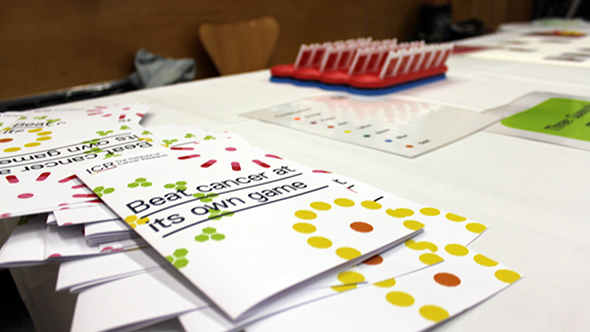
ICR volunteers used games to explain the role of evolution in cancer research to visitors, who included TV weather presenter Sian Lloyd.
A sunny weekend is a good time to do lots of things — to visit parks, meet friends and family, do some gardening or prepare a Sunday roast. And as I discovered earlier this month, a sunny weekend is also ideally suited to talking about science.
Last weekend, Imperial College London held the Imperial Festival 2016, known as #impfest, at its South Kensington campus on 7–8 May 2016. This annual festival promotes science and the arts through a wide range of different activities — from a jazz concert with the Imperial Big Band to talking to researchers about cancer.
The Institute of Cancer Research, London, had at stand at this year’s festival and its theme was ‘Beating cancer at its own game’; focusing on explaining how the patterns of Darwinian evolution apply to cancer and the implications this has for cancer treatment.
On the ICR’s stand, a group of 14 volunteers — including PhD students, early-career researchers and senior scientists — were determined to explain this complex subject to our audience.

The ICR stand at the Imperial Festival 2016
Before describing what cancer evolution means for efforts to treat the disease, we first had to explain what evolution is and why it is such a central concept for biology. To help in the explanation and to attract children (and several grown-ups too) we had some games available to help visitors to understand the complex subject.
The first game was based on Darwin’s diagram of evolution, the tree of life, showing how evolution follows a branching pattern. Visitors had to colour in and stick leaves on our 3D tree model according to the colour of the other leaves in the different branches, finding the correct branch.
It worked well to explain how mutations accumulate over time and drive change, and to later describe heterogeneity in cancer and how complex a tumour may be.
'Survival' board game
We talked about targeted treatments, explaining that sometimes these only worked on certain branches of the tumour — just pruning the foliage, rather than cutting down the trunk. That ran the risk of leaving some of the tumour behind, and leading to drug resistance.
This is considered one of the biggest challenges in cancer research and treatment. We illustrated the topic with a game we called ‘Survival of the nastiest’. It was a board game where we asked people to guess which cancer cell would survive after three rounds of treatment.

ICR volunteers used games to help explain what cancer evolution means for research and treatment
Each cancer cell wore different piece of armour — for example, a shield — that would confer resistance to a specific drug. Visitors started to notice that the cancer cells with the widest array of armour on would have the greatest chance of surviving the treatments — illustrating the ‘survival of the nastiest’.
At the end of this game, it was great to receive feedback from some of our visitors that they now realised how complex cancers can be and why may be so difficult to treat it.
Guess Who?
Our third game ended on a positive note, as we introduced some of the approaches we are using to overcome these problems of heterogeneity and drug resistance. They were illustrated by a variation of the board game ‘Guess Who?’
Instead of using various features of the characters to narrow down to your opponent’s selection, visitors chose treatments that would be effective at treating cards of certain colours, representing particular mutations that could be targeted.
If they managed to find the founder mutation (the first mutation present in all the cancer cells as the ‘trunk of the tree’) that would allow all cells be killed using a specific treatment.
If they were not able to find and target the founder mutation, visitors were encouraged to try again using two treatments at the same time. As you could expect, it is much easier to win the game if you can use multiple treatments and indeed combination therapy is one of the approaches we are using to overcome heterogeneity and resistance.
Explaining complex topics
As well as all these games, we were asked many questions and were able to explore the theme in a little more depth. I even overheard a question to one of my colleagues about cancer stem cells.
I could not avoid asking the children if they knew what they wanted to be when they grew up to see if they could be tempted to follow a career as researcher. I remember having that idea when I was their age and I still cherish having the opportunity to pursue this path.
By the end of the festival, I could really feel that our stand was able to elucidate an extremely complex subject to the public and a range of visitors with really different backgrounds.
This was all helped by the attractive and relaxing environment promoted by the warm sunny days over the weekend. From a personal point of view, of the reasons you could find to promote science, I found all of them in that sunny weekend.
comments powered by